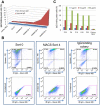Identification and characterization of Ixodes scapularis antigens that elicit tick immunity using yeast surface display
- PMID: 21246036
- PMCID: PMC3016337
- DOI: 10.1371/journal.pone.0015926
Identification and characterization of Ixodes scapularis antigens that elicit tick immunity using yeast surface display
Abstract
Repeated exposure of rabbits and other animals to ticks results in acquired resistance or immunity to subsequent tick bites and is partially elicited by antibodies directed against tick antigens. In this study we demonstrate the utility of a yeast surface display approach to identify tick salivary antigens that react with tick-immune serum. We constructed an Ixodes scapularis nymphal salivary gland yeast surface display library and screened the library with nymph-immune rabbit sera and identified five salivary antigens. Four of these proteins, designated P8, P19, P23 and P32, had a predicted signal sequence. We generated recombinant (r) P8, P19 and P23 in a Drosophila expression system for functional and immunization studies. rP8 showed anti-complement activity and rP23 demonstrated anti-coagulant activity. Ixodes scapularis feeding was significantly impaired when nymphs were fed on rabbits immunized with a cocktail of rP8, rP19 and rP23, a hall mark of tick-immunity. These studies also suggest that these antigens may serve as potential vaccine candidates to thwart tick feeding.
Conflict of interest statement
Figures






Similar articles
-
Probing an Ixodes ricinus salivary gland yeast surface display with tick-exposed human sera to identify novel candidates for an anti-tick vaccine.Sci Rep. 2021 Aug 3;11(1):15745. doi: 10.1038/s41598-021-92538-9. Sci Rep. 2021. PMID: 34344917 Free PMC article.
-
Salp25D, an Ixodes scapularis antioxidant, is 1 of 14 immunodominant antigens in engorged tick salivary glands.J Infect Dis. 2001 Oct 15;184(8):1056-64. doi: 10.1086/323351. Epub 2001 Sep 28. J Infect Dis. 2001. PMID: 11574922
-
Identification of novel conserved Ixodes vaccine candidates; a promising role for non-secreted salivary gland proteins.Vaccine. 2022 Dec 12;40(52):7593-7603. doi: 10.1016/j.vaccine.2022.10.032. Epub 2022 Nov 8. Vaccine. 2022. PMID: 36357287
-
Ixodes scapularis saliva components that elicit responses associated with acquired tick-resistance.Ticks Tick Borne Dis. 2020 May;11(3):101369. doi: 10.1016/j.ttbdis.2019.101369. Epub 2020 Jan 3. Ticks Tick Borne Dis. 2020. PMID: 31924502 Free PMC article.
-
Ixodid-host immune interaction. Identification and characterization of relevant antigens and tick-induced host immunosuppression.Vet Parasitol. 1986 Mar;20(1-3):149-74. doi: 10.1016/0304-4017(86)90098-1. Vet Parasitol. 1986. PMID: 2422805 Review.
Cited by
-
Application of M13 phage display for identifying immunogenic proteins from tick (Ixodes scapularis) saliva.BMC Biotechnol. 2015 May 30;15:43. doi: 10.1186/s12896-015-0167-3. BMC Biotechnol. 2015. PMID: 26024663 Free PMC article.
-
Tick spit shines a light on the initiation of coagulation.Circulation. 2013 Jul 16;128(3):203-5. doi: 10.1161/CIRCULATIONAHA.113.003800. Epub 2013 Jul 1. Circulation. 2013. PMID: 23817576 Free PMC article. No abstract available.
-
Chemical Equilibrium at the Tick-Host Feeding Interface:A Critical Examination of Biological Relevance in Hematophagous Behavior.Front Physiol. 2019 May 1;10:530. doi: 10.3389/fphys.2019.00530. eCollection 2019. Front Physiol. 2019. PMID: 31118903 Free PMC article. Review.
-
A combined transcriptomic approach to identify candidates for an anti-tick vaccine blocking B. afzelii transmission.Sci Rep. 2020 Nov 18;10(1):20061. doi: 10.1038/s41598-020-76268-y. Sci Rep. 2020. PMID: 33208766 Free PMC article.
-
Laboratory Management of Mammalian Hosts for Ixodes scapularis -Host-Pathogen Interaction Studies.Comp Med. 2024 Aug 1;74(4):235-245. doi: 10.30802/AALAS-CM-24-036. Comp Med. 2024. PMID: 39289828 Free PMC article. Review.
References
-
- Estrada-Pena A, Jongejan F. Ticks feeding on humans: a review of records on human-biting Ixodoidea with special reference to pathogen transmission. Exp Appl Acarol. 1999;23:685–715. - PubMed
-
- Anderson JM, Valenzuela JG. Tick saliva: from pharmacology and biochemistry to transcriptome analysis and functional genomics, in Ticks – Biology, Disease and Control. Bowman and Nuttall (Cambridge University Press) 2008:92–107.
-
- Anguita J, Ramamoorthi N, Hovius JW, Das S, Thomas V, et al. Salp15, an ixodes scapularis salivary protein, inhibits CD4(+) T cell activation. Immunity. 2002;16:849–859. - PubMed
-
- Schroeder H, Daix V, Gillet L, Renauld JC, Vanderplasschen A. The paralogous salivary anti-complement proteins IRAC I and IRAC II encoded by Ixodes ricinus ticks have broad and complementary inhibitory activities against the complement of different host species. Microbes Infect. 2007;9:247–250. - PubMed
Publication types
MeSH terms
Substances
Grants and funding
LinkOut - more resources
Full Text Sources
Other Literature Sources
Medical
Research Materials

